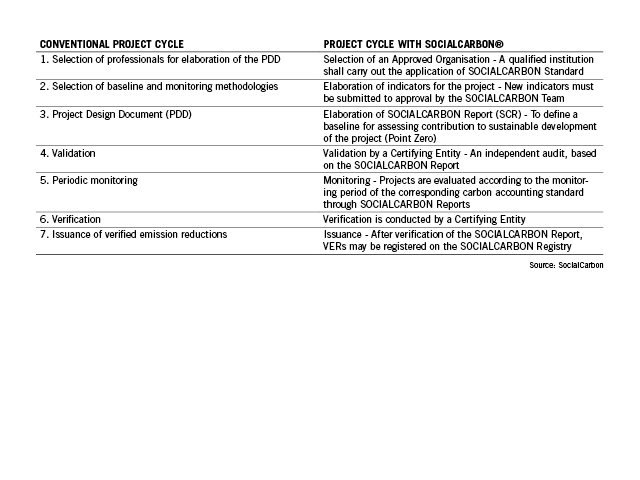
SocialCarbon
Content
SocialCarbon is a standard that “certifies emission reduction projects for their contribution to sustainable development.” It is “founded on the principle that transparent assessment and monitoring of the social and environmental performance of projects can improve their long-term effectiveness and thus add value to the emission reductions generated.” Its goal is to ensure a project’s contribution to sustainable development, improve social and environmental benefits, and contribute to project differentiation in the market.
Introduction
The Brazilian non-governmental organisation Ecologica Institute developed the first SocialCarbon methodology in 2000 and manages the standard. It can be used for any climate change mitigation project, but was originally created for forest-dependent communities. The standard is designed as complementary (i.e. as an “add-on”) to other GHG accounting standards, and therefore does not itself contain criteria for GHG emissions (e.g. additionality, baselines, etc.). Requirements for SocialCarbon certification include (i) a 'SocialCarbon report’ with information about the project, written by a developer previously authorized by the Ecologica Institute; (ii) the use of SocialCarbon methodologies for verifying the social, environmental and economic performance of projects, (iii) monitoring and continual improvement of project performance, and (iv) independent auditing.. Indicators on the social, environmental and economic performance of projects are selected from a preapproved list, or new indicators can be submitted, focusing on six aspects of sustainable development (social, human, financial, natural, biodiversity and carbon). A list of existing approved indicators can be found online which includes material for forest carbon projects including REDD.
SocialCarbon is the most prevalent co-benefit standard after the Climate, Community and Biodiversity (CCB) standard, with 23% market share of all project types in 2011, although forestry projects played a small role in this.
Design Features
SocialCarbon has been designed as a complementary (add-on) standard for co-benefits of any GHG mitigation project and has no criteria regarding project type.
Similar to scope, SocialCarbon has been designed as a complementary (add-on) standard for co-benefits of any GHG mitigation project and has no criteria regarding project size, making it also applicable to larger scale jurisdictional programmes.
Project developers establish a “Point Zero” baseline using the standard’s indicators, which determine the degrees of sustainability of the six resources: social, human, financial, natural, biodiversity and carbon. Developers must demonstrate an improvement along the project’s lifetime in relation to this baseline, evidence of which is established through the monitoring reports (see Measurement and Monitoring).
Socialcarbon relies on the methodologies of the GHG accounting standard applied to the project to evaluate additionality of GHG reductions or removals. For social and other environmental factors the “point zero” baseline provides a ‘snap shot’ of the six evaluated resources during the project’s first stage (see Reference Levels).
Leakage is expected to be addressed by the methodologies of the greenhouse gas standard applied to the project.
Permanence is expected to be addressed by the methodologies of the greenhouse gas standard applied to the project.
The SocialCarbon Standard includes a variety of indicators from which project proponents may select or develop their own. For forest projects, preapproved indicators include: compliance with social demands, addressing land tenure and resource rights, enhanced livelihoods (including income generation, access to credit, employment opportunities), benefit sharing (including support to social programmes), human resources (including improved skills, knowledge, capacities and health), and population displacement. As the standard is based on continuous improvement there is no minimum requirement for achieving each indicator. The Indicators for Forest Projects do not specifically address gender or vulnerable groups or the need to implement Free, Prior, and Informed Consent, although they do include potential indicators related to compliance with social demands, acceptance of the project, and avoidance of conflict.
The SocialCarbon Standard includes a variety of indicators from which project proponents may select or develop their own. For forest projects, preapproved indicators include three categories related to environmental safeguards: (a) stock of natural resources and environmental services from which resources of livelihoods are derived (indicators include protected areas, water and soil resources, native ecosystems, etc.); (b) biodiversity (with indicators such as species conservation, natural communities, research and information, etc.); and (c) carbon resource (including indicators for measurement, monitoring, validation and verification, and project performance—leakage and permanence are expected to be addressed under the complementary carbon accounting standard chosen). As the standard is based on continuous improvement there is no minimum requirement for achieving each indicator.
The SocialCarbon Standard includes a variety of indicators from which project proponents may select or develop their own. For forest projects, preapproved indicators include those related to stakeholder participation, political risk and regulatory approval (including accordance with existing national or subnational REDD+ programmes), consultation (i.e. a systematic approach for communicating with stakeholders), and conflict resolution. There are not, however, specific preapproved indicators related to safeguard information systems or transparency. As the standard is based on continuous improvement there is no minimum requirement for achieving each indicator.
The project must be periodically monitored, and each monitoring period must present a new SocialCarbon Report that includes an update on all indicators. Monitoring should be in accordance with the monitoring periods of the carbon accounting standard being used.
Markit manages SocialCarbon’s Registry, which tracks credits and all project details.
An Approved Organization selects, adapts or creates indicators applicable to monitor the project’s contribution to sustainable development, collects necessary information for assessment of each indicator, and produces a SocialCarbon Report, complying with the template and guide. Independent auditing, verification and validation by a third party, based on the SocialCarbon Report, is required.



 Twitter
Twitter Google+
Google+ Facebook
Facebook LinkedIn
LinkedIn Digg
Digg del.icio.us
del.icio.us StumbleUpon
StumbleUpon